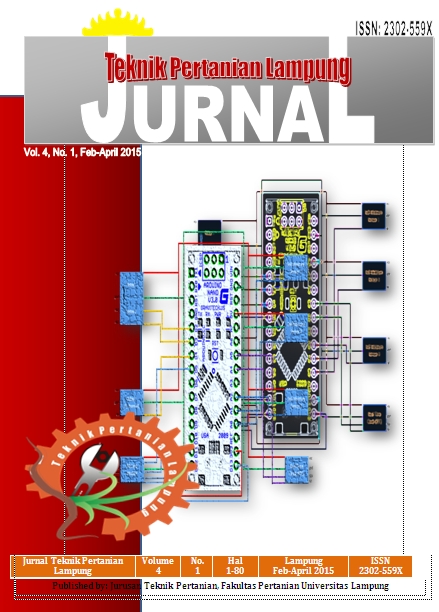DESIGN OF AUTOMATIC DRIP IRRIGATION BASED ON CHANGE OF SOIL WATER CONTENT USING ARDUINO NANO MICROCONTROLLER
DOI:
https://doi.org/10.23960/jtep-l.v4i1.%25pAbstract
Formerly, most of Indonesian farmers only used a timer in an effort to set up drip irrigation scheduling. Thismethod is less effective in providing irrigation according to crop water requirement because it is only able to
arrange the provision of irrigation basedon a predetermined time interval only, so that the excess or lack ofwater
cant be controlled. This research makes an instrument which is able to overcome these problems, that is by
designing an automatic control systemonregulating the provision of irrigationwater in drip irrigation by using
amicrocontroller thatworks based onchange of soilwater content. The parameters observed inthis studyare the
change of soilwater content, irrigationflowrate, bulk density of soil, and dropper flowuniformity. This study uses
three types of growingmedium, i.e. sand, red-yellowpodzolic soil, andmix soil with organic nitrofosfat fertilizer.
Calibration tests showed a linear function, for sandmedium y = − 0.23x + 46.96 with percent error ± 5.22%, for
red-yellowpodzolic soil andmix soilwith organic nitrofosfat fertilizermediumy = − 0.71x + 104.07with percent
error ± 2.92%. The results showed that the automatic control system is able to work well, i.e. turn on the pump
when soilwater content drops belowthe criticalwater contentand turnoff the pumpwhen soilwater content rises
over the field capacity.
Downloads
Published
2015-05-01
Issue
Section
Articles
License
- Authors who publish with this journal agree to the following terms:
- Authors retain copyright and grant the journal right of first publication with the work simultaneously licensed under a Creative Commons Attribution-ShareAlike 4.0 International Lice that allows others to share the work with an acknowledgement of the work's authorship and initial publication in this journal.
- Authors are able to enter into separate, additional contractual arrangements for the non-exclusive distribution of the journal's published version of the work (e.g., post it to an institutional repository or publish it in a book), with an acknowledgement of its initial publication in this journal.
- Authors are permitted and encouraged to post their work online (e.g., in institutional repositories or on their website) prior to and during the submission process, as it can lead to productive exchanges, as well as earlier and greater citation of published work (See The Effect of Open Access).
Jurnal Teknik Pertanian Lampung

JTEPL is licensed under a Creative Commons Attribution-ShareAlike 4.0 International License.

